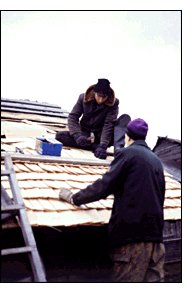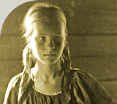 |
| Background |
| Aims |
| Achievements |
| Revitalisation in pictures |
| Current news |
| Main page | Background | Villages | Revitalisation | Cultural tourism | Map | |
|
|
In the 1980s, and even today, many Viena families use two languages at home. The most typical practice is that the parents speak Karelian together; and even though they speak Karelian to their children, the children respond in Russian. In other words, the mother tongue has become a language of which Viena children have only a passive knowledge.This would hardly have occurred had the inhabitants of these small villages been allowed to continue their lives as they had done for centuries. After the wars, the small villages that had come back to life were purposely deserted in the 1960s and 1970s. The village collective farms were terminated and in their place was established - in the folklore villages area - the Uhtua sovkhoz, or state farm. Its centre was in Uhtua and the brigades were located in Vuokkiniemi and Vuonninen. The other villages were destroyed. Villagers had no choice but to leave their homes. To ensure that no one would remain the authorities discontinued all public services, that is, schools, stores, post offices, libraries, bakeries were all closed. In addition, people were paid to move their houses out of the villages as well.
Among others, Latvajärvi, Kivijärvi, Venehjärvi, Ponkalahti, Pirttilahti, Tollonjoki, Alajärvi, Enonsuu, Jyvöälahti and Haikola lost their status as villages during the 1960s and 1970s. Even right after the war, villages such as Kostamus, Kontokki, Luusalmi, Sompajärvi, Vuokinsalmi, Niskajärvi, Saarijärvi, and Lonkka were deserted. In a matter of a few decades, villages that once had had valuable cultural and historical pasts were wiped off the map. The villages were not completely left to revert to forest, however, because in the summers the hayfields were cut for the livestock at the state farm and parts of the villages were used for pasture lands. This explains why some houses were spared in these villages. The administrative changes did little to increase food production in the northwest corner of the Soviet Union. In fact, the Kalevala Region soon began to slide into a state of underdevelopment. In the past, the village collective farms had managed to provide their livestock - and even the livestock of their labourers - with winter feed. After the reforms, they were forced to transport hay to Uhtua all the way from the Ukraine. Initially, even the Viena population was convinced that the decision to turn Kostomuksha into a mining town would solve the economic problems of the Kalevala Region. Unfortunately, the town hailed as the new Sampo in official speeches soon turned out to be a disappointment. While Moscow prospered, the Kalevala Region suffered. Instead of bringing wealth to region, the results were pollution and an overwhelming number of migrants. In fact, the newcomers soon outnumbered locals by two to one. Not only were the newcomers indifferent to local traditions, they showed little respect for them. Soon after the construction work began, Kostomuksha was separated from the Kalevala Region to form an independent administrative area and then it absorbed Vuokkiniemi and its nearby villages into its principal food production area. Nevertheless, the Ukrainian management was dissatisfied with the level of production at the Vuokkiniemi state farm. Thus, plans were made to tear down the entire village, and, replace it with a Baltic-style dairy farm complete with production buildings and dwellings built of bricks and a geometrical plan. The workers for this top production unit would also be brought from elsewhere and Vuokkiniemi inhabitants would have been relocated to live in cities.
When the plans were being formulated, private ownership was unheard of in the Soviet Union, which was then still politically intact. There was no official border station between Finland and the Soviet Union and no tourists had ever visited Viena. Moreover, the folklore villages were situated in the so-called closed zone, a place restricted even to Soviet citizens unless granted a special permit. Nevertheless, the plans were set in motion. Accordingly, the Kajaani
Agricultural Institute began to provide agricultural training for
those people in Vuokkiniemi with families to support and a desire
to return to their home villages; in the province of Oulu a collection
of agricultural machinery was organised, which yielded a tractor
for every future farmer in the programme; land transfers were granted
to private farmers - for the first time in the history of the Soviet
Union; and, since 1991, cultural tours of the folklore villages
have been given regularly. To support the revitalisation efforts, the Revitalising Project of the Viena Karelian Folklore Villages was established as an international project involving The Arhippa Perttunen Foundation and the Juminkeko Foundation. Initially, a large-scale investigation was undertaken to assess what had to be done and then detailed plans were made. The plans covered language preservation, protection of the cultural milieu by the restoration and construction of historical buildings, electrification of the villages and road construction. In the year 1993, the Revitalising Project of the Karelian Folklore Villages was recognised by UNESCO as an activity of World Decade for Cultural Development. In 1996, one of the folklore villages, Paanajärvi, which was bound for destruction because of the power plant, was, thanks to the application made by the Juminkeko recognised on the list of 100 endangered cultural sites by the World Monuments Watch during 1996 to 1997 and again during 1998 to 2001. |
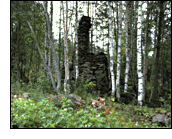 The
Second World War brought devastation to the Viena villages and the
majority of the inhabitants were evacuated. Everyone who could returned,
but rarely could entire families return to their home village. After
the wars, schools provided pupils with Finnish instruction so that
the children whose language skills had suffered during the period
of evacuation would regain their linguistic competence. As of 1956,
however, school instruction was given in Russian. This meant that
even in the 1960s, the majority of the pupils beginning their studies
failed to understand their lessons. After all, Karelian remained
a home language in the homes where both parents spoke the language.
In the 1970s, however, the impact of the language law forbidding
the use of any other language than Russian in kindergarten began
to have an impact. At this time, Karelian began to lose its status
as a home dialect among young children.
The
Second World War brought devastation to the Viena villages and the
majority of the inhabitants were evacuated. Everyone who could returned,
but rarely could entire families return to their home village. After
the wars, schools provided pupils with Finnish instruction so that
the children whose language skills had suffered during the period
of evacuation would regain their linguistic competence. As of 1956,
however, school instruction was given in Russian. This meant that
even in the 1960s, the majority of the pupils beginning their studies
failed to understand their lessons. After all, Karelian remained
a home language in the homes where both parents spoke the language.
In the 1970s, however, the impact of the language law forbidding
the use of any other language than Russian in kindergarten began
to have an impact. At this time, Karelian began to lose its status
as a home dialect among young children. 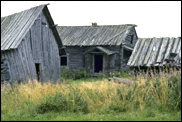
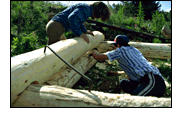 At
this stage, in 1989, the Revitalising Project of the Viena Karelian
Folklore Villages was initiated. The project's original purpose
was to preserve Vuokkiniemi, but was soon expanded to include other
deserted and significant folklore villages by returning their former
inhabitants and descendants to live there. The first plans were
made with Santeri Lesonen, who was then chairman of the Vuokkiniemi
village council and Markku Nieminen, a Finnish writer. Initially,
support for the plan was acquired from the Karelian cultural sphere
and later higher officials also got involved. Reintroducing private
farming, finding commercial uses for surviving handicraft traditions
and organising international cultural tourism were all regarded
as effective ways to revitalise the villages.
At
this stage, in 1989, the Revitalising Project of the Viena Karelian
Folklore Villages was initiated. The project's original purpose
was to preserve Vuokkiniemi, but was soon expanded to include other
deserted and significant folklore villages by returning their former
inhabitants and descendants to live there. The first plans were
made with Santeri Lesonen, who was then chairman of the Vuokkiniemi
village council and Markku Nieminen, a Finnish writer. Initially,
support for the plan was acquired from the Karelian cultural sphere
and later higher officials also got involved. Reintroducing private
farming, finding commercial uses for surviving handicraft traditions
and organising international cultural tourism were all regarded
as effective ways to revitalise the villages.
